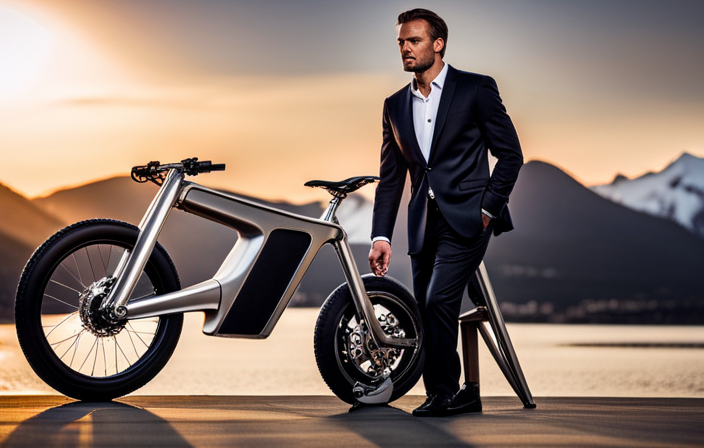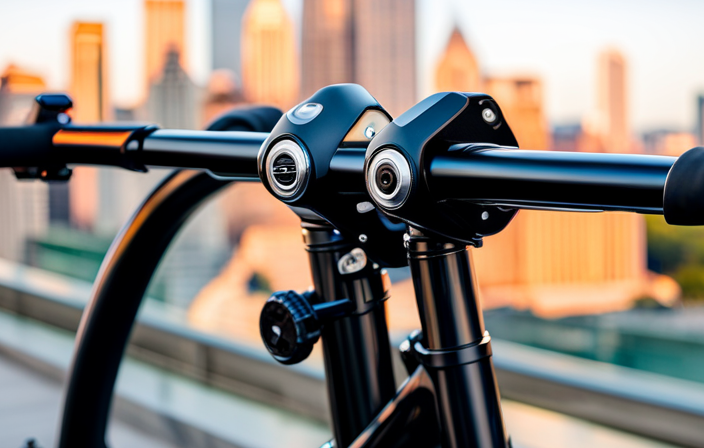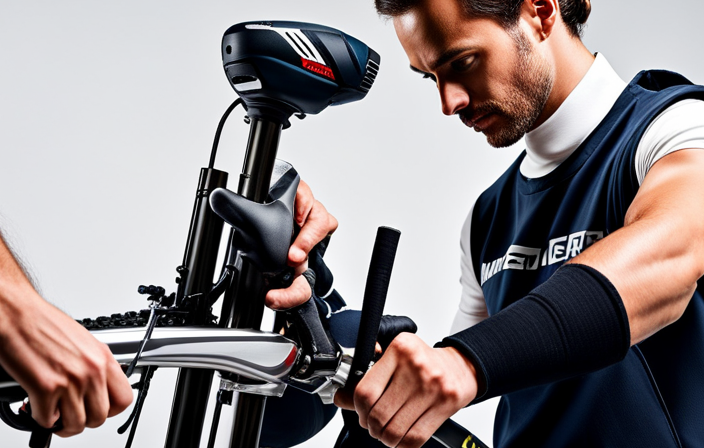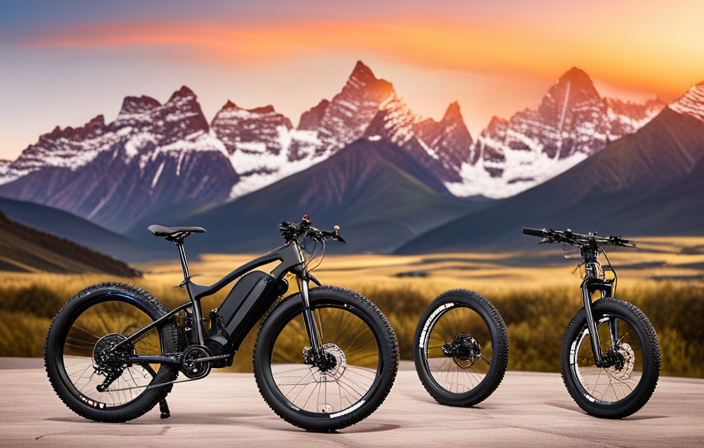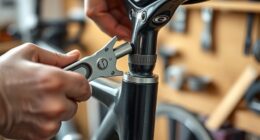As a passionate cyclist, I can’t help but feel anxious at the thought of my electric wheel detaching from my bike. This is a situation that every rider dreads, but it is important to understand why it occurs for our own safety.
In this article, we will explore the various factors that can lead to the detachment of an electric wheel from a bike. From loose nuts and bolts to incorrect installation, we will dive into the technicalities and provide you with the knowledge to prevent such a mishap.
Key Takeaways
- Loose nuts and bolts, worn-out bearings, incorrect installation, overloading the bike, and damage to the axle are common causes of electric wheel detachment.
- Riding on rough terrain, excessive vibrations, proper torque, and the role of bearings in wheel stability are factors that can affect wheel stability.
- Regular maintenance and inspections, including checking axle nuts and inspecting wheel spokes, are important for preventing electric wheel detachment.
- Factors related to electric wheel quality, such as defective or low-quality wheels, improper tire pressure, overheating, corrosion or rusting, and impact or collision, can also contribute to the wheel coming off the bike.
Loose Nuts and Bolts
Make sure you tighten all the nuts and bolts on your electric wheel to prevent it from coming off while riding. A loose wheel can be a dangerous situation, causing loss of control and potential accidents.
When assembling your electric wheel, it is crucial to ensure that all nuts and bolts are properly tightened to the manufacturer’s recommended torque specifications. Failure to do so can result in a wheel that gradually becomes loose over time, leading to wobbling and instability. Improper torque can also cause stress on the wheel’s components, leading to premature wear and damage.
It is important to use a torque wrench to achieve the correct torque values and periodically check for any loosening. By properly tightening all nuts and bolts, you can avoid the risk of a loose wheel and ride with confidence.
Moving on to worn-out bearings…
Worn-out Bearings
The worn-out bearings may cause the wheel to loosen on the bike. It is crucial to pay attention to the condition of the bearings as they play a significant role in the stability and performance of the electric wheel.
Here are four reasons why worn-out bearings can lead to a loose wheel:
-
Friction increases: As the bearings wear out, the friction between the wheel and the bike frame intensifies, making it easier for the wheel to become loose.
-
Reduced support: Worn-out bearings lose their ability to provide proper support to the wheel, resulting in increased movement and potential loosening.
-
Misalignment: When bearings deteriorate, they can cause misalignment between the wheel and the bike frame, leading to instability and the risk of the wheel coming off.
-
Increased wear on other components: Loose nuts and bolts can put additional strain on bearings, accelerating their deterioration.
With worn-out bearings, the risk of the electric wheel coming off the bike becomes significantly higher. However, another crucial factor that can contribute to this issue is the incorrect installation of the electric wheel.
Incorrect Installation of the Electric Wheel
You should ensure that you properly install the electric wheel to avoid any potential issues. One of the most common installation mistakes is not checking the electric wheel compatibility with your bike.
It is crucial to make sure that the wheel size, axle diameter, and dropout spacing are all compatible with your bike frame. Failure to do so can lead to an improperly seated wheel, which can result in it coming off during use.
Another mistake is not tightening the axle nuts or quick-release skewer sufficiently. This can cause the wheel to become loose and eventually detach from the bike.
Lastly, improper alignment of the wheel can also contribute to it coming off. It is important to align the wheel properly with the frame to ensure a secure fit.
Failing to address these installation mistakes can lead to accidents and injuries.
Now, let’s move on to the next section about overloading the bike.
Overloading the Bike
Overloading your bike can lead to instability and potential accidents if not properly balanced. Improper weight distribution is one of the main factors that can affect bike stability.
When you load your bike with too much weight, especially on the rear, it can cause the front wheel to lift and affect your ability to steer and control the bike. The weight should be evenly distributed between the front and rear of the bike, with heavier items placed lower and closer to the center. This will help maintain stability and prevent the bike from becoming top-heavy.
If the bike is overloaded and the weight is not properly distributed, it can put excessive stress on the axle, leading to potential damage and even the wheel coming off. Therefore, it is crucial to ensure proper weight distribution to maintain bike stability and prevent any damage to the axle.
Damage to the Axle
Improper weight distribution can cause damage to the axle if your bike is overloaded. It is crucial to ensure that the weight on your bike is evenly distributed to prevent excessive strain on the axle. Here are four key considerations to avoid damaging the axle:
-
Load distribution: Distribute the weight evenly between the front and rear of the bike. An uneven load can put excessive stress on the axle, leading to potential damage.
-
Weight limits: Be mindful of the weight limits specified by the manufacturer. Exceeding these limits can increase the risk of axle damage.
-
Tire pressure: Maintaining proper tire pressure is essential. Insufficient tire pressure can result in increased stress on the axle, potentially leading to damage.
-
Suspension setup: Adjusting the suspension according to the load can help distribute weight more effectively and reduce strain on the axle.
By following these guidelines, you can minimize the risk of axle damage and ensure a safe and enjoyable ride.
Now let’s delve into the next section about riding on rough terrain.
Riding on Rough Terrain
When riding on rough terrain, it’s important to maintain a firm grip on the handlebars to ensure control and stability.
To enhance your off-road biking experience, there are a few key aspects to consider: suspension systems and tire selection.
Suspension systems play a vital role in absorbing the impact of bumps and uneven surfaces, providing a smoother ride. Look for a bike with adjustable suspension settings to match the intensity of the terrain you’ll be tackling.
Additionally, choosing the right tires for rough terrain is crucial. Opt for wider tires with aggressive tread patterns that offer better traction and grip. These tires will provide stability and prevent slippage on loose or uneven surfaces.
By focusing on suspension systems and tire selection, you can ride with confidence and tackle rough terrain with ease.
Transitioning into the next section, excessive vibrations can cause damage to various components of your bike.
Excessive Vibrations
Excessive vibrations can be detrimental to the overall performance and longevity of your bike. When the suspension system is not properly calibrated, it can lead to increased vibrations that can compromise the stability and control of the bike. It is crucial to ensure that the suspension system is regularly inspected and maintained to prevent excessive vibrations.
Additionally, tire balancing plays a significant role in reducing vibrations. When the tires are not balanced correctly, it can cause uneven weight distribution, resulting in vibrations during rides. Regular tire balancing can help maintain a smooth and comfortable ride, minimizing the impact on the bike’s components.
However, excessive vibrations can also be caused by poor maintenance and inspections, which we will discuss in the next section.
Poor Maintenance and Inspections
As we discussed in the previous subtopic, excessive vibrations can lead to the detachment of an electric wheel from a bike. However, another common reason for wheel detachment is poor maintenance and inspections. It is crucial to regularly inspect the condition of your electric wheel to prevent any potential hazards. Here are some prevention tips and common signs of wheel detachment to look out for:
| Prevention Tips | Common Signs of Wheel Detachment |
|---|---|
| Regularly tighten the wheel nuts | Wobbling or loose wheel while riding |
| Check the spoke tension | Unusual noises coming from the wheel area |
| Inspect the wheel rims for cracks or damage | Uneven wear on brake pads or rim edges |
Defective or Low-Quality Electric Wheel
Using a low-quality or defective electric wheel can pose significant safety risks. It is crucial to choose the right electric wheel to ensure a safe and enjoyable riding experience. Here are three key factors to consider when selecting an electric wheel:
-
Quality: Opt for electric wheels from reputable manufacturers known for their high-quality products. This ensures that the wheel is built to withstand rigorous use and reduces the chances of it malfunctioning or coming off.
-
Durability: Look for electric wheels made from durable materials that can withstand the demands of daily riding. Wheels that are built to last are less likely to fail unexpectedly, reducing the risk of accidents.
-
Certification: Check if the electric wheel has undergone proper safety testing and certification. Look for certifications like UL or CE, which indicate that the wheel meets stringent safety standards.
Transitioning into the subsequent section about ‘improper tire pressure,’ maintaining the correct tire pressure is vital for electric wheel safety.
Improper Tire Pressure
Make sure you regularly check the tire pressure on your electric wheel to ensure optimal safety and performance. Improper tire inflation can lead to a variety of issues, including tire blowouts. When the tire is not properly inflated, it puts excessive stress on the sidewalls, making them more susceptible to failure. This can result in a sudden loss of air pressure, causing the tire to blow out while in use.
A tire blowout can be extremely dangerous, especially at higher speeds, as it can cause loss of control and accidents. To avoid this, it is essential to regularly check the tire pressure and inflate it according to the manufacturer’s recommendations. By maintaining proper tire pressure, you can prevent the risk of a tire blowout and ensure a safe and smooth ride on your electric wheel.
Transitioning into the subsequent section about ‘overheating of the electric wheel,’ it is important to note that improper tire pressure can contribute to the overheating issue.
Overheating of the Electric Wheel
To prevent overheating, it’s important to keep an eye on the temperature of your electric wheel and take breaks if it starts to get too hot. Overheating can lead to damage and reduce the lifespan of your wheel. Here are some tips for overheating prevention and troubleshooting overheating issues:
-
Monitor the temperature: Keep an eye on the temperature gauge or indicator on your electric wheel. If it starts to rise rapidly or reaches unsafe levels, it’s time to take action.
-
Reduce load: If you’re carrying heavy cargo or climbing steep hills, the motor may be working harder and generating more heat. Consider reducing the load or taking breaks to let the wheel cool down.
-
Proper ventilation: Make sure the wheel has adequate ventilation. Avoid covering it with bags or other items that may block airflow.
-
Regular maintenance: Keep the wheel clean and free from dirt or debris that could obstruct airflow or cause overheating.
By following these practices, you can prevent overheating and ensure the optimal performance and longevity of your electric wheel.
Next, let’s discuss another potential issue: corrosion or rusting of the wheel components.
Corrosion or Rusting of the Wheel Components
If you notice corrosion or rust on the components of your electric wheel, it’s important to address it promptly to prevent further damage. Corrosion can weaken the structural integrity of the wheel and affect its overall performance. To prevent corrosion, regular maintenance and proper lubrication are essential. Here is a table outlining some tips for corrosion prevention and proper lubrication:
| Corrosion Prevention | Proper Lubrication |
|---|---|
| Clean the wheel regularly to remove dirt and debris that can promote corrosion. | Use a lubricant specifically designed for electric wheels to ensure smooth operation. |
| Apply a corrosion-resistant coating to protect the wheel from moisture and oxidation. | Lubricate the bearings and axles to reduce friction and wear. |
| Check for any signs of rust or corrosion during routine inspections and address them immediately. | Avoid over-lubricating, as excess lubricant can attract dirt and debris. |
Impact or Collision
When you experience an impact or collision, it’s crucial to assess the condition of your electric bike’s components to ensure they are still functioning properly.
Not only can collisions cause damage to the frame and other parts of the bike, but they can also affect the wheels.
To prevent wheel failure after a collision, it’s important to inspect the spokes, rims, and tires for any signs of damage or misalignment.
Tightening loose spokes, replacing bent rims, and repairing punctured tires are all steps that should be taken to maintain proper wheel function.
Inadequate wheel alignment can lead to a host of problems, including increased friction, decreased stability, and even premature wear of the components.
Therefore, it’s crucial to address any issues with wheel alignment promptly to avoid future complications.
Inadequate Wheel Alignment
Checking for signs of misalignment in your bike’s wheels is crucial to ensuring proper function and preventing potential issues. Misalignment can occur due to various causes, such as improper installation, wear and tear, or even impact from accidents.
When the wheels are not aligned correctly, it can lead to several consequences. First, it affects the handling and stability of the bike, making it harder to steer and control. This can be particularly dangerous when riding at high speeds or in challenging terrain. Additionally, inadequate wheel alignment can cause uneven tire wear, reducing the lifespan of your tires and increasing the risk of a blowout.
Maintaining proper alignment is essential for the overall performance and safety of your electric wheel.
Now, let’s dive into the next section to explore the impact of age and wear on the electric wheel.
Age and Wear of the Electric Wheel
As the electric wheel ages and experiences wear, it may become more prone to misalignment and other issues. This is due to age-related issues and the effects of wear and tear.
The following are some key points to consider regarding the age and wear of the electric wheel:
- Increased risk of misalignment and imbalance, leading to decreased stability and control.
- Gradual deterioration of wheel components, such as bearings and spokes, causing potential failure.
- Weakening of the wheel’s structural integrity, making it susceptible to damage from impacts and road vibrations.
- Reduced efficiency and performance due to worn-out motor components and electrical connections.
- Higher likelihood of punctures and tire wear, resulting in decreased traction and increased risk of accidents.
It is crucial to regularly inspect and maintain the electric wheel to mitigate these age-related issues and ensure optimal performance and safety.
Frequently Asked Questions
Can riding on rough terrain cause the electric wheel to come off the bike?
Yes, riding on rough terrain can cause the electric wheel to come off the bike. Improper riding technique and an unbalanced weight distribution can put excessive stress on the wheel, leading to detachment.
How does poor maintenance and inspections contribute to the electric wheel coming off?
Improper maintenance and lack of inspections can contribute to the electric wheel coming off the bike. Failure to regularly check bolts, bearings, and alignment can result in loose or damaged components, compromising the wheel’s stability and increasing the risk of detachment.
What are the risks of using a defective or low-quality electric wheel?
Using a defective or low-quality electric wheel can lead to serious risks of accidents and severe consequences of malfunction. Safety concerns include loss of control, instability, and potential injury to the rider and others on the road.
Can improper tire pressure affect the stability of the electric wheel?
Improper tire pressure can affect the stability of the electric wheel. Improper installation and impact damage are also factors that can lead to instability and potential detachment of the wheel from the bike.
How does overheating of the electric wheel lead to it coming off the bike?
When an electric wheel overheats, it can lead to disastrous consequences, including the detachment from the bike. This is due to the severe impact overheating has on the wheel’s structural integrity, making regular maintenance crucial to prevent such incidents.
Conclusion
In conclusion, the electric wheel coming off a bike can be attributed to various factors. Just like the components of a well-oiled machine, our lives can also experience unexpected setbacks.
Just as loose nuts and bolts, worn-out bearings, and incorrect installation can cause the wheel to detach, our own neglect and ignorance can lead to unforeseen consequences. It is crucial to stay vigilant, address any issues promptly, and prioritize maintenance.
Remember, just like the electric wheel, our lives require constant care and attention to ensure smooth and safe journeys.

